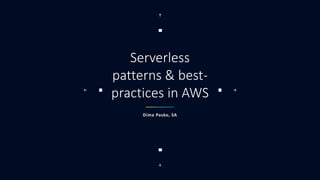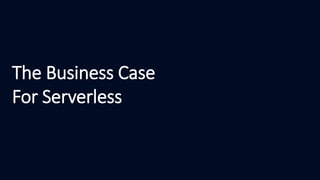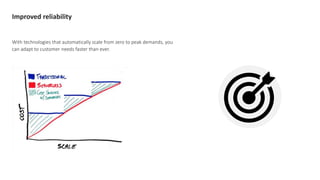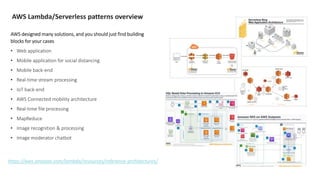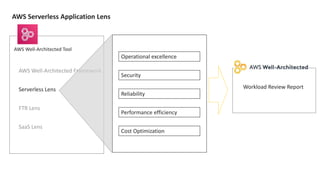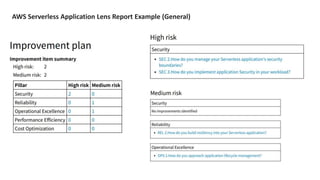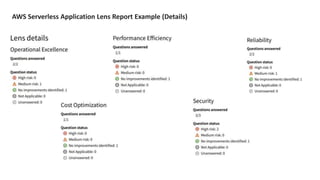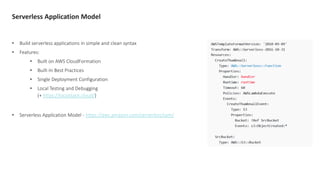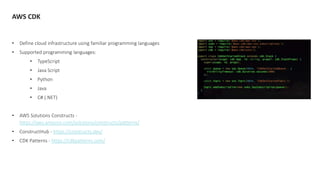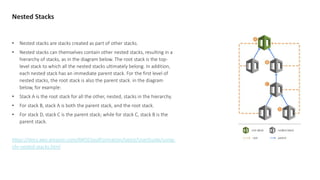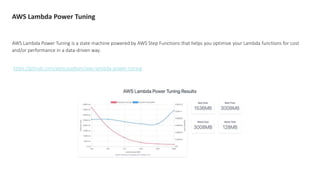AWS Serverless patterns & best-practices in AWS
- 1. Serverless patterns & best- practices in AWS Dima Pasko, SA
- 2. This presentation has been prepared by EPAM Systems, Inc. solely for use by EPAM at its EPAM Zed Conference. This presentation or the information contained herein may not be reproduced or used for any other purpose. This presentation includes highly confidential and proprietary information and is delivered on the express condition that such information will not be disclosed to anyone except persons in the recipient organization who have a need to know solely for the purpose described above. No copies of this presentation will be made, and no other distribution will be made, without the consent of EPAM. Any distribution of this presentation to any other person, in whole or in part, or the reproduction of this presentation, or the divulgence of any of its contents is unauthorized. CONFIDENTIAL INFORMATION
- 3. Dima Pasko Solution Architect II EPAM Systems
- 4. What Serverless Is Serverless computing is a cloud computing execution model in which the cloud provider allocates machine resources on demand, taking care of the servers on behalf of their customersŌĆ” ┬® Wikipedia https://en.wikipedia.org/wiki/Serverless_computing
- 5. The Business Case For Serverless
- 6. Focus on business value, not infrastructure 1. F A S T E R T I M E T O M A R K E T 2. 3. R E D U C E D C O S T S I M P R O V E D R E L I A B I L I T Y 6 4. I N C R E A S E D R AT E O F I N N O VAT I O N
- 7. Faster time to market By eliminating operational overhead, your teams can release quickly, get feedback, and iterate to get to market faster.
- 8. Reduced costs With a pay-for-value billing model, you never pay for over-provisioning and your resource utilization is optimized on your behalf.
- 9. Improved reliability With technologies that automatically scale from zero to peak demands, you can adapt to customer needs faster than ever.
- 10. Increased rate of innovation Serverless applications have built-in service integrations, so you can focus on building your application instead of configuring it.
- 11. AWS Serverless Design Patterns & Solutions Review
- 12. AWS Lambda/Serverless patterns overview AWS designed many solutions, and you should just find building blocks for your cases ŌĆó Web application ŌĆó Mobile application for social distancing ŌĆó Mobile back-end ŌĆó Real-time stream processing ŌĆó IoT back-end ŌĆó AWS Connected mobility architecture ŌĆó Real-time file processing ŌĆó MapReduce ŌĆó Image recognition & processing ŌĆó Image moderator chatbot 12 https://aws.amazon.com/lambda/resources/reference-architectures/
- 13. AWS Serverless Application Lens 13 AWS Well-Architected Tool AWS Well-Architected Framework Serverless Lens FTR Lens SaaS Lens Operational excellence Security Reliability Performance efficiency Cost Optimization Workload Review Report
- 14. AWS Serverless Application Lens Report Example (General) 14
- 15. AWS Serverless Application Lens Report Example (Details) 15
- 16. Serverless Myths & Design Anti-Patterns
- 17. Myths Myth #1: Serverless means ŌĆ£no server and hardwareŌĆØ ŌĆó You need to setup required RAM size Myth #2: Serverless == Lambda (AWS Lambda, Azure Functions etc.) ŌĆó Amazon enumerates as serverless such services as S3, SQS, SNS, API Gateway, DynamoDB Myth #3: Serverless is cheap, definitely cheaper than ŌĆ£serverfullŌĆØ solution ŌĆó Not always, you always should calculate costs ahead to see if itŌĆÖs good fit
- 18. Going Stateful Anti-Pattern Antipattern #1: Going stateful (in-memory state) Problem ŌĆó Though lambda instance can be preserved for the next requests (such called ŌĆ£hot startŌĆØ), it is not guaranteed ŌĆó After lambda run, lambda instance can be terminated anytime Solution ŌĆó You need a state, store it in external services 18
- 19. Do Not Pay Attention To Service Specifics Antipattern #2: Do not pay attention to service specifics Problem ŌĆó ŌĆ£I just write my code and deploy it to AWS Lambda ŌĆō and everything worksŌĆØ ŌĆō right, but only if you agree with terms of service. AWS Lambda for example, have number of limitations (quotas): ŌĆó Request size <= 6Mb (so you cannot use it for file upload, use S3 for that) ŌĆó Max execution time is 15 minutes (lambda is terminated by timeout then) Solution ŌĆó Regularly revisit quotas, know your data, check if they fit ŌĆó Remember there are hard and soft limits, soft limits can be increased on request 19
- 20. My Favorite Stack Is Great At Lambdas Antipattern #3: Use your favorite tech stack without paying attention at cost Problem ŌĆó Startup can be much slower in comparison to using plain old java or another language ŌĆó You are charged on a second basis. Reducing overall duration from 10 seconds to 5 seconds will cut your costs twice ŌĆó Decreasing memory size (because code in Java was rewritten in Go) by two times will cut your costs twice Solution ŌĆó As lambda should be small, you can write it in Go/Python/JavaScript even if you are not a Pro in this language ŌĆó So the pattern is: consider if the cost benefit worth learning 20
- 21. Multithreading Is Great In Lambdas Antipattern #4: Using old-fashioned way for orchestration Problem ŌĆ£I will save a record in DynamoDB from lambda and then Thread.sleep for another service to update itŌĆÖs statusŌĆØ ŌĆó Each second if lambda does not do anything, you still pay money ŌĆó Avoid explicit and try to avoid implicit waits ŌĆó Implicit wait ŌĆō blocking lambda instance awaiting for response from synchronous calls (RESTs) ŌĆó Explicit wait ŌĆō Thread.sleep, polling messages from queues in while loops, checking state in while loops etc. Solution ŌĆó Orchestration using AWS Step Functions ŌĆó Choreography using message brokers (SQS, EventBridge, Kinesis, DynamoDB Streams) 21
- 23. Serverless Application Model ŌĆó Build serverless applications in simple and clean syntax ŌĆó Features: ŌĆó Built on AWS CloudFormation ŌĆó Built-In Best Practices ŌĆó Single Deployment Configuration ŌĆó Local Testing and Debugging (+ https://localstack.cloud/) ŌĆó Serverless Application Model - https://aws.amazon.com/serverless/sam/
- 24. AWS CDK ŌĆó Define cloud infrastructure using familiar programming languages ŌĆó Supported programming languages: ŌĆó TypeScript ŌĆó Java Script ŌĆó Python ŌĆó Java ŌĆó C# (.NET) ŌĆó AWS Solutions Constructs - https://aws.amazon.com/solutions/constructs/patterns/ ŌĆó ConstructHub - https://constructs.dev/ ŌĆó CDK Patterns - https://cdkpatterns.com/
- 25. Nested Stacks ŌĆó Nested stacks are stacks created as part of other stacks. ŌĆó Nested stacks can themselves contain other nested stacks, resulting in a hierarchy of stacks, as in the diagram below. The root stack is the top- level stack to which all the nested stacks ultimately belong. In addition, each nested stack has an immediate parent stack. For the first level of nested stacks, the root stack is also the parent stack. in the diagram below, for example: ŌĆó Stack A is the root stack for all the other, nested, stacks in the hierarchy. ŌĆó For stack B, stack A is both the parent stack, and the root stack. ŌĆó For stack D, stack C is the parent stack; while for stack C, stack B is the parent stack. https://docs.aws.amazon.com/AWSCloudFormation/latest/UserGuide/using- cfn-nested-stacks.html
- 26. Know Your Limits ŌĆó LambdaŌĆÖs executions ŌĆó Concurrent executions - 1,000 ŌĆó Step Functions ŌĆó Maximum number of registered state machines - 10,000 ŌĆó Maximum open executions per account - 1,000,000 executions per AWS account. ŌĆó ENIs for Lambdas are not endless ŌĆó Elastic network interfaces per virtual private cloud (VPC) - 250 ŌĆó Limit on S3 buckets for Lambdas ŌĆó Buckets - 100 per account
- 27. AWS Lambda Power Tuning AWS Lambda Power Tuning is a state machine powered by AWS Step Functions that helps you optimize your Lambda functions for cost and/or performance in a data-driven way. https://github.com/alexcasalboni/aws-lambda-power-tuning
- 28. DB Connections Management Serverless works best with services rather than connections. Connection management: ŌĆó Application connection pooling ŌĆó RDS Proxy ŌĆó Amazon Aurora Serverless v2 ŌĆó Data API ŌĆó Dynamo DB ŌĆó https://aws.amazon.com/blogs/database/best-practices-for-working- with-amazon-aurora-serverless/
- 29. Thank you! For more information, contact Dima Pasko Solution Architect II Dmytro_Pasko@epam.com https://www.linkedin.com/in/dimapasko
Editor's Notes
- #2: Hello ZED Conference 2021 LetŌĆÖs talk about ŌĆ”
- #3: Based on real life experience in Insurance domain
- #4: Kharkiv, Ukraine Solution Architect Passionate and successful Architect with over 17 years of experience including 6 years of experience in Software Architecture Experience in Digital Transformation projects with Microservices & Serverless Multi-cloud experience: AWS, Azure
- #5: Next evolution of cloud computing. Serverless <> not only lambda, it is serverless DBs Engines, Container services, BPMN engines. Servers not have gone you do not manage them only.
- #8: Faster time to market (Business logic ŌĆō> API) ŌĆō >Messaging & Orchestration -> Storage & Databases -> Compute -> Physical Infrastructure AWS Lambda automatically runs your code without requiring you to provision or manage infrastructure. Just write the code and upload it to Lambda either as a ZIP file or container image. Focus on most important part of your application Technology abstraction allows us to focus on building just the pieces of code and configuration that are providing truly unique value for the client. Productive for the day one
- #9: Cost optimized with millisecond metering With AWS Lambda, you only pay for the compute time you consume, so youŌĆÖre never paying for over-provisioned infrastructure. You are charged for every millisecond your code executes and the number of times your code is triggered. At its most basic, the cost case for serverless boils down to utilization. YouŌĆÖve probably seen the numbers ŌĆö traditional, on-premise datacenter servers tend to be only 15 to 30% utilized. (WeŌĆÖve even heard that most large EC2 users struggle to reach this utilization rate as well!) Put the other way, that means 70 to 85% of your server costs are dead weight. Waste. ąÉąĮą░ą╗ąŠą│ąĖčÅ ŌĆō ą░ą▒ąŠąĮąĄą╝ąĄąĮčé ą▓ čüą┐ąŠčĆčéąĘą░ą╗ąĄ No hidden costs: Security Platform outdated (personal story) test environment for 18 teams ~ $400
- #10: Scale from zero to infinity and back Consistent performance at any scale(smooths) With AWS Lambda, you can optimize your code execution time by choosing the right memory size for your function. You can also keep your functions initialized and hyper-ready to respond within double digit milliseconds by enabling Provisioned Concurrency.
- #11: Easy to start new project, very cheap, modularity, elasticity Experiments, new environment, iteration cycle A lot of integrations. Event based. Out of the box. Architecture improvement: breaking the monolith into functions that could be independently deployed, meant that they were better able to split the team up to work on more things in parallel, and to deploy each feature separately Next evolution of cloud computing. Continuously improving: ARM + Graviton
- #13: DonŌĆÖt invent a wheel and review AWS resources Try to search and adopt existing to your case Also this is a good reason to learn how to draw diagrams for AWS
- #14: AWS Well-Architected Framework The AWS Well-Architected Framework Lens provides a set of foundational questions for you to consider for all of your cloud architectures. Serverless Lens Description The AWS Serverless Application Lens provides a set of additional questions for you to consider for your serverless applications.
- #15: Tell how you open AWS console, add workload, grouped questions, download a report
- #16: Tell how you open AWS console, add workload, grouped questions, download a report
- #18: Serverless can gain polarized opinion starting from ŌĆ£use it everywhere, itŌĆÖs cool!ŌĆØ to ŌĆ£just a hype, IŌĆÖm good with my Java 5 + tomcatŌĆØ And this emotional attitude often drives technology selection ThatŌĆÖs why this slide is more about myths about serverless than about antipatterns Myth #1: Serverless means ŌĆ£no server and hardwareŌĆØ Servers not have gone you do not manage them only. And sometimes this abstraction leaks ŌĆō for lambda you need to setup required RAM size Serverless more means ŌĆ£no infrastructure workŌĆØ ŌĆō all the infrastructure maintenance is on provider Portability, Vendor lock Myth #2: Serverless == Lambda (AWS Lambda, Azure Functions etc.) As Serverless means ŌĆ£no infrastructure workŌĆØ, many of services familiar to you are already serverless. AWS S3 for example. Amazon enumerates as serverless such services as S3, SQS, SNS, API Gateway, DynamoDB Even modification of Aurora falls into this category Myth #3: Serverless is cheap, definitely cheaper than serverfull solution Not always, you always should calculate costs ahead to see if itŌĆÖs good fit Not all workloads are suitable for serverless Example from Insurance domain, predictable load Ad tech, stock exchange ŌĆō could bad domain example
- #19: The Sirens & Odysseus Antipattern #1: Going stateful (in-memory state) We are not talking about state saved in external service (caches like Redis, databases etc) ŌĆō that approach is fine But accumulating in-memory state is definitely antipattern: Though lambda instance can be preserved for the next requests (such called ŌĆ£hot startŌĆØ), it is not guaranteed After lambda run, lambda instance can be terminated anytime So the pattern is: if you need a state, store it in external services. For fast access use distributed caches as AWS ElastiCache (managed Redis) You CAN go with in-memory state if you know what you are doing (lambdas are in warm state, have provisioned/reserved concurrency on ŌĆō so instances will likely be reused)
- #20: Icarus
- #21: Myth of Jason and the Argonauts Antipattern #3: Use your favorite tech stack without paying attention at cost ŌĆ£I will write this on Spring BootŌĆØ can have such downsides: You might need more memory for lambda than for the same logic written in Go or Python (up to 4 times and more) Startup can be much slower in comparison to using plain old java or another language Can be mitigated by keeping lambda at warm state for hot start Often for cold start the startup time can be longer than processing time itself Both memory size and startup time add a cost You are charged on a second basis. Reducing overall duration from 10 seconds to 5 seconds will cut your costs twice Decreasing memory size (because code in Java was rewritten in Go) by two times will cut your costs twice As lambda should be small, you can write it in Go/Python/JavaScript even if you are not a Pro in this language So the pattern is: consider if the cost benefit worth learning a bit of Python No Dependency Injection frameworks?
- #22: King Midas and his touch Antipattern #4: Using old-fashioned way for orchestration ŌĆ£I will save a record in DynamoDB from lambda and then Thread.sleep for another service to update itŌĆÖs statusŌĆØ Each second if lambda does not do anything, you still pay money Design for retries So the pattern is: Avoid explicit and try to avoid implicit waits Implicit wait ŌĆō blocking lambda instance awaiting for response from synchronous calls (RESTs) Explicit wait ŌĆō Thread.sleep, polling messages from queues in while loops, checking state in while loops etc. Use Cloud-Native way of logic organization: Orchestration using AWS Step Functions choreography using message brokers (SQS, EventBridge, Kinesis, DynamoDB Streams)
- #26: Nested Stacks Monorepo ŌĆō one repo for workload Good to keep order, atomic deployments, PR in one repo, easier engennering best practices
- #27: 11. AWS Account strategy (Sizing (Account per Team), sharing resources, hard to performance test, limits) a. See Laura's Blog for some details on Lambda Concurrency issues :https://myconnections.lmig.com/blogs/n0085283/2019/03/14/aws-lambdas-setting-a-max-concurrency-its-consequences Best practices: - Dashboards Alerts, Notifications Sets of best practices
- #29: Nested Stacks

